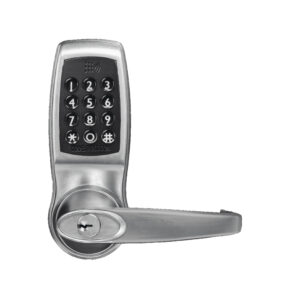 The CL4500 GD lock is described as a “medium duty, electronic patch lock offering all the benefits of Codelocks’ Smart Technology”. “Suitable for inswing doors, the lock fits existing Rondo type glass door preparations”. The lock is supplied with a standard strike for solid door frames or an optional glass door strike box for use with Rondo prepared glass side panels can be purchased. This makes it ideally suited to offices, meeting rooms and hired spaces.
The CL4500 GD lock is described as a “medium duty, electronic patch lock offering all the benefits of Codelocks’ Smart Technology”. “Suitable for inswing doors, the lock fits existing Rondo type glass door preparations”. The lock is supplied with a standard strike for solid door frames or an optional glass door strike box for use with Rondo prepared glass side panels can be purchased. This makes it ideally suited to offices, meeting rooms and hired spaces.
The lock is operated using keypad entry and / or RFID cards and with a key override. No wiring is required and a two-year guarantee is standard.
Getting started
The removable cylinder is encased in a zinc alloy housing with a brushed steel finish. Various parts are included in the package to position and secure the lock to the glass door. The door can be from 8 to 15mm thick and may be left or right hung. A useful YouTube video is available to run through the details.
Removing the back plate of the assembly that is held in place by 4 x M4 cross-head screws gives access to the two battery holders. These hold the 4 x LR1 size N, 1.5v batteries that are series connected. Once fitted the unit is ready for fitting to the door and programming.
The external handle freely moves when the lock is not activated. Entering a valid 4-digit key code or presenting a programmed card triggers an internal clutch that engages with the latch actuator and allows the door to be opened. The keypad emits a blue flash and double beep for a valid entry or a red flash and longer beep for an invalid entry or card presentation.
The lock is supplied with two override keys that can be used to open the lock at any time. These can be supplied “keyed alike” if required.
Menu options
The lock is quickly programmed using the numeric keypad and a range of simple commands. The keypad has 12 buttons consisting of the usual 0 to 9 telephone format layout, with * and # keys completing the set. The * key is reserved for certain programmes and when using NetCodes and the # key is used for programming the device.
An initial 8-digit factory-set master code is used to access the device, and this must be changed after installation.
Read the full review in the November 2022 edition of PSI magazine

